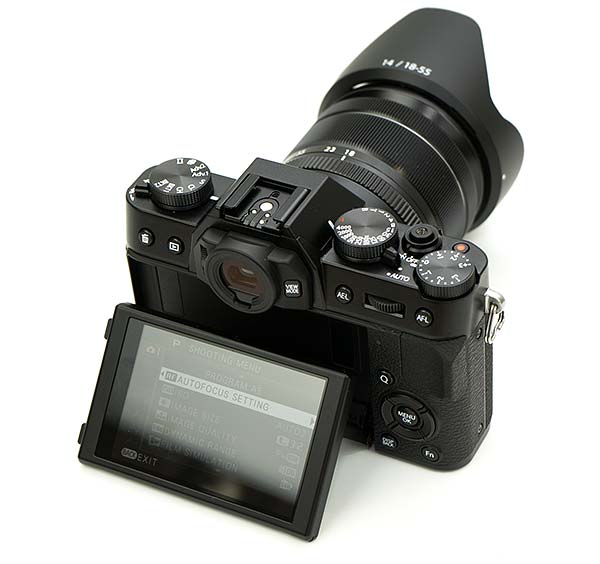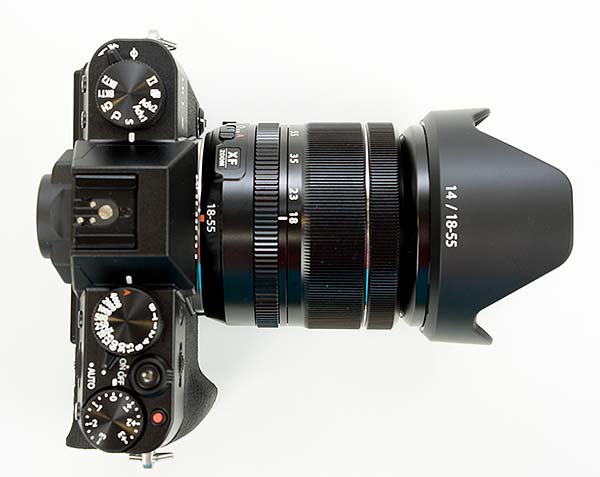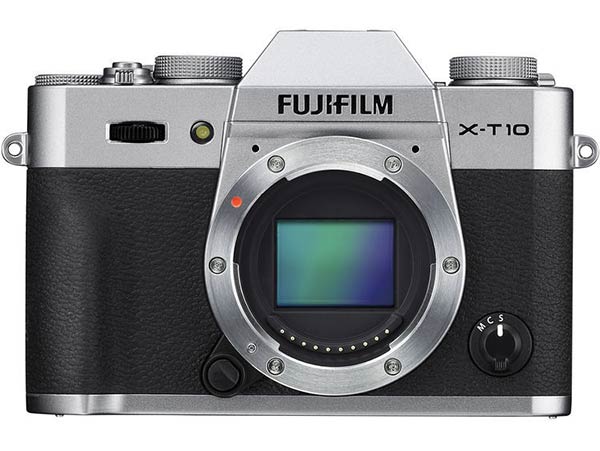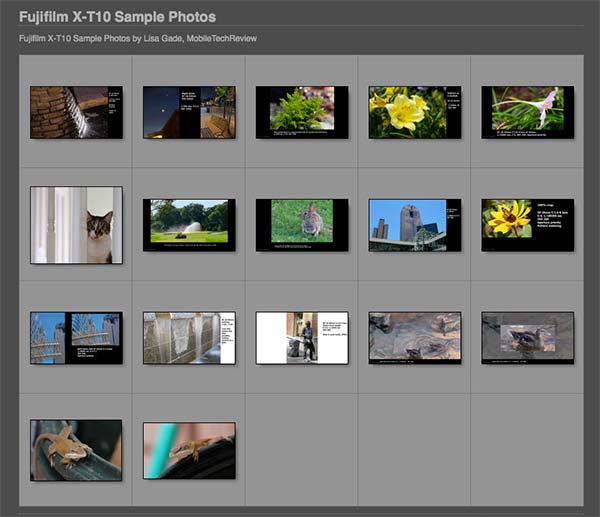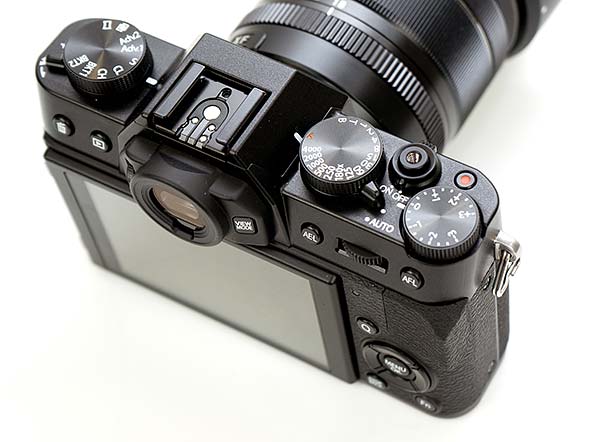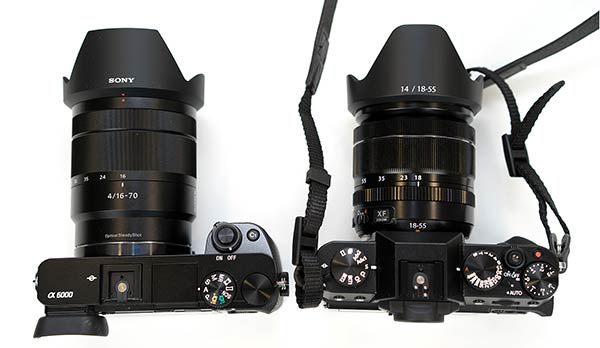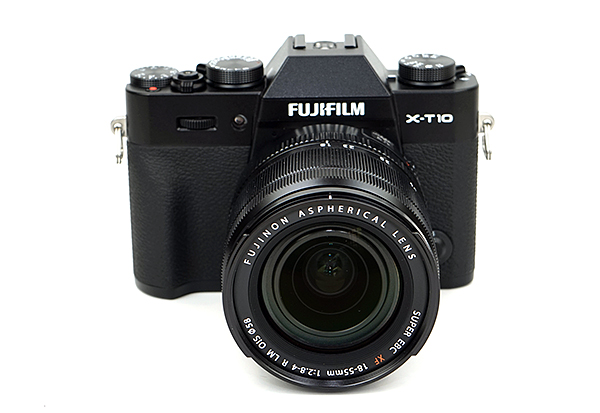
|
|
|||||||
|
Home > Camera Reviews > Fujifilm X-T10
Fujifilm X-T10
What's Hot: Fantastic image quality, great controls, good selection of quality lenses, small and light. What's Not: Grip may be too small for some, built-in flash is weak.
Reviewed July 7, 2015 by Lisa Gade, Editor in Chief (twitter: @lisagade, Instagram lisagadeMTR)
|
|||||
|
Some cameras just make you feel brilliant-- Fujifilm X series cameras, for example. I'm a serious photographer, and us "serious" types tend to shoot RAW to bring out shadow detail, control highlights and improve color balance in our images. With the Fujifilm X-T10, like the older and more expensive X-T1, I often use the out of camera JPEGs. I just can't improve on these images--there's a tiny Fuji engineer/Photoshop guru sitting inside the camera, and she saves me tons of work. Of course, that's not literally true, but Fuji's image processing algorithms are phenomenal. We can chase megapixels, esoteric lenses and specs, but in the end there's only one important thing: the image and its quality. The Fujifilm won't help you make better compositions or master lighting, but it will give you incredibly sharp, detailed and colorful images straight out of the camera. These images can compete with mirrorless and dSLRs that cost significantly more, and there are times when I choose it over my full frame Sony a7 and Canon 6D when going out to shoot. This is a compact, high quality camera with Fuji's X-Trans CMOS II 16MP APS-C sensor with EXR processor II. The underlying sensor is Sony, which is fine with us since Sony is at the top of their game and their sensors are used in many great cameras. Fujifilm customized or reengineered the sensor with their own non-Bayer color filter array, and in the process managed to omit the AA filter that's common to most other digital cameras and reduces sharpness. The result is images that are so sharp that they survive aggressive cropping while still looking superb, obviating the need for a larger full frame sensor or higher resolution. Ah, but what about night photography where full frame sensors are ideal since they gather more light and generate less noise than APS-C sensors? The X-T10 holds up remarkably well, particularly with a stabilized lens that allows for lower shutter speeds and thus lower ISOs. Up to 3200 ISO actually looks quite usable (6400 if you're not picky), and the difference between the X-T10 and the Sony a7 is surprisingly small. The Canon EOS 6D still wins for nighttime color and clarity since it's one of the best dSLRs for night photos, but it doesn't put the X-T10 into the box of shame.
The Fuji can shoot 1080p video at 60fps in MOV format, and it shoots JPEG and RAW in photo mode. It also has an excellent auto mode and Fujifilm's film simulations of Provia, Velvia, Astia and Chrome films. The X-T10 boasts a fast new auto-focus system with focus tracking (49 point single point, 77 point for Zone and Wide Tracking modes). It has both PDAF and contrast focus detection. The camera has a built-in flash, WiFi, downloadable smartphone apps, and geotagging. Build Quality and Ergonomics The body is mostly metal, and it feels and looks like a quality piece. It's available in classic silver or all black. The $799 Fuji X-T10 has the same imaging hardware and quality as the more expensive X-T1, with a slightly smaller and lighter body and no weatherproofing. If you want to lighten your load, the X-T10 is one of the most portable APS-C cameras on the market. If you have large hands, or even average man-sized hands, then the camera might feel a bit too small. I get right hand cramps when trying to hold the small grip in one hand for periods of time, and that's why Fuji offers a $159 handgrip you can screw on (yes, it's not cheap). I also find the Sony a6000 too small to hold comfortably with one hand, and the Sony a7 is as small as I can go before discomfort sets in. That's me--you may be different. Try it in a store if you can. It's not enough to stop me from buying the camera, not when I like everything else about it so much and when neck straps are a practical solution. Oh, my right hand is constantly accidentally activating the d-pad upper button too, changing flash settings. Fortunately, Fuji has an option to lock the d-pad buttons (they likely had the same problem). When using the camera two-handed in shooting position, the buttons, dials and wheels are laid out ergonomically. I love the front and rear wheels to quickly change aperture and shutter speed. The top dials are metal and tactile. The X-T10 feels like a photographer's camera and not a piece of consumer electronics. The rear LCD's articulating mechanism doesn't feel overly delicate or flimsy.
LCD and Viewfinder The camera has a 3" LCD that goes up and down but not sideways and does not reverse for selfies. It's colorful and sharp with 920k dots and is bright enough to see in sun. The Fujifilm X-T10 has a 3.26 million dot OLED EVF and full manual controls with a shutter speed dial, EV dial and drive mode dial (there's no ISO dial unlike the XT-1). This is the sort of camera you can understand without a deep dive into the manual, thanks to the copious traditional hardware controls that save you from living in the menus. The EVF is very sharp and colorful in that OLED sort of way (it makes everything look a bit more colorful and contrasty). I love the auto-brightness feature--no more blanched viewfinder in bright sunlight, and you can actually see clearly when shooting night scenes. Simply lovely! The advantage of a mirrorless camera is that the electronic viewfinder shows you exactly what the sensor sees. You can also customize info displayed on the EVF and enable focus peaking (that which is in focus will be highlighted in white or red--your choice). This is a joy for precise manual focusing. You can set the camera to AF+MF (autofocus that you can tweak with the focus ring for all modes other than SR+ full auto) or set the front dial to manual, single shot autofocus or continuous autofocus. Standbys like AF lock and AE lock are on board too, and you can decouple focus from the shutter button (which is threaded). Fujinon Lenses Rock We used at the camera with the 18-55mm f/2.8-4 optional higher end kit zoom lens, XF 55-200mm lens and the truly lovely XF 35mm f/1.4 prime. With an ILC (interchangeable lens camera), lens selection is every bit as important as the body, and Fujinon X mount XF lenses for their X series cameras are top notch for construction, sharpness and colors without breaking the bank. There are more affordable XC series lenses with plastic barrels and slower apertures--they have very good image quality for the price too, but I'd go with XF lenses to capitalize on the X-T10 (and X-T1) image quality and potential in low light. The selection of lenses covers the popular suspects, and more are coming this and next year, including a tempting 90mm f/2 lens. The higher end kit lens option adds $300 to the price (it's $600 if purchased separately), and it's perhaps the best kit zoom among any brand. That 18-55mm f/2.8-4 lens is extremely sharp, has OIS and covers a popular focal range of 27-84mm in 35mm equivalence (multiply focal length by 1.5 to convert Fuji's APS-C to 35mm focal length). Fujinon lenses have very impressive OIS, and when the camera wanted to shoot at 1/8th of a second for a night shot with the OIS zoom, I though it had lost it's digital mind. As it turns out, those photos were sharp and the OIS is simply that good.
As compared to the Sony E mount collection for the NEX and a6000 (crop sensor lenses), Fujinons are overall higher quality in terms of image quality and materials. As compared to the Sony FE full frame E mount lenses--well, those lenses are quite expensive (many are $1,000 or more) and they have slower max apertures. The lineup is improving for FE, but it's still slim. Several (not all) of the FE lenses are rather large and heavy relative to the Sony a7/a7 II/a7R/a7S--that's the price we pay for full frame. Fujinon lenses are smaller and lighter and balance better on the camera and are less of a burden to carry. Flash? So the good news is that there's a tiny pop-up flash hidden in the faux-pentaprism area. To deploy it, slide a lever next to the drive mode dial up top. The bad news is that it's nearly useless. I tried using it as a fill flash for product shots (smartphones at close range in a room that's well served by sunlight and a pair of 600 watt continuous lights). That should be the perfect use for a tiny flash, but it honestly did nada. I then tried using it for a portrait in a dimly lit living room and once again, it made little difference. Happily the hot shoe was ready for my Fujifilm EF-42 flash. It looks comically large on the little X-T10 but it's a powerful flash with a bounce head (and more flash power than I really needed). |
Deals and Shopping:
Advertisement |
||||
|
Fujifilm X-T10 Video Review
Image Gallery * Click on a photo to see a larger image in a new window. |
Advertisement |
Focus Speeds Fujifilm claims extremely fast focus times thanks to phase detection on-sensor in addition to the usual contrast detection. The older X-T1 was many things, but a focus speed demon it wasn't (though it made the Sony a7 and a7R with earlier firmware versions seem like chilled molasses). The X-T1 got the major 4.0 firmware update just after the release of the X-T10, and I'd say the X-T10 is a fast focusing mirrorless camera and is still faster than the X-T1 for continuous tracking. Note that I say for mirrorless, because much as I love them, they're still not as fast as the better dSLRs. For sports and birds in flight I'd still go with a dSLR. Mirrorless is improving quickly, and in a few more years they may catch up. For most everything else, the X-T10 is quick to focus. I've successfully captured more birds in flight and crazy cat escapades with the Fujifilm than with my Sony a7, but the Sony a6000 is the quickest of the trio (and notoriously fast to focus). The Canon EOIS 6D is quickest of all. With the XT-10, focus speed is somewhat dependent on the lens--newer designs are quicker to focus, like the XF 56mm f/1.2. Though the not very new XF 18-55mm f/2.8-4 is really quick and accurate, while the 2012 XF 35mm f/1.4 (a fine 50mm equivalent lens that takes stunning photos) is slower to focus and still hunts/chatters when left in continuous focus mode (even with the latest firmware). Blame the lens design, not the camera... the XF 35mm is not dog slow and it never missed focus, but you will notice it focusing. The X-T10 has modern mirrorless amenities like face detection and eye detection, along with various focus settings like flexible spot, zone and wide tracking. Video Video isn't Fujifilm's prime directive in their consumer camera lineup. If you just want to take pleasing and detailed 1080p vacation footage at 60fps in MOV format, you'll love it. If you're using it professionally or semi-professionally, there are alternatives with AVCHD and XAVC S higher quality codecs like the cheaper Sony a6000 (which also has clean HDMI out for monitoring). Panasonic also has better video recording offerings, from the 4K Lumix LX100 to the bigger and more expensive GH4. The camera's stereo mics do a decent job of capturing audio, but if you want to use an external mic, you'll have to find one with a 2.5mm jack or get a 3.5 to 2.5mm adapter (no phantom power mics allowed). Conclusion I respect APS-C cameras, and they have definite advantages when you need longer focal lengths (thanks to the 1.5x crop factor), need wider depth of field (there are times when paper-thin in focus zones are a pain on full frame cameras) or when you want to travel smaller and lighter. That said, I've been a "full frame gal" when it comes to my personal gear for the past 2.5 years. The Fujifilm X-T10 has changed that. The image quality with the X-Trans II sensor and no AA filter, combined with those excellent and fairly priced XF lenses has me hooked. The camera is very well built, is designed for photographers (hardware controls, intuitive to experienced shooters). The image quality--did I mention that? Of course I did--it's stupendous and much more than I'd have expected from a 16MP camera. Good job, Fujifilm. Website: www.fujifilm.com Price: $799 body only, $899 with XC kit lens and $1,099 with XF kit lens Related Reviews and Articles: 5 Photography Tips to Improve Your dSLR and Phone Photos dSLR vs. Mirrorless Cameras: What's the Difference and Which Should You Buy? |
Directly above: the Sony a6000 with Zeiss 16-70mm lens and the Fujifilm X-T10 with 18-55mm lens.
|
|

